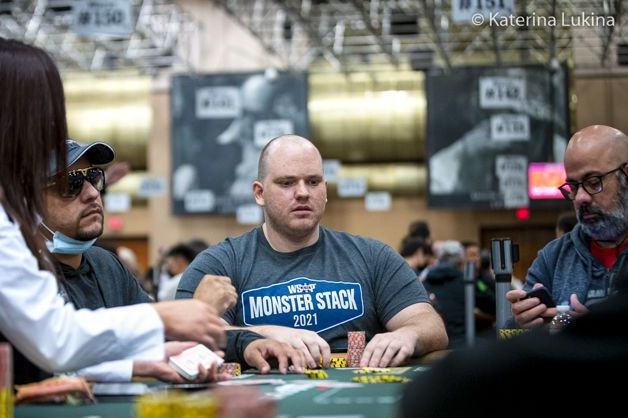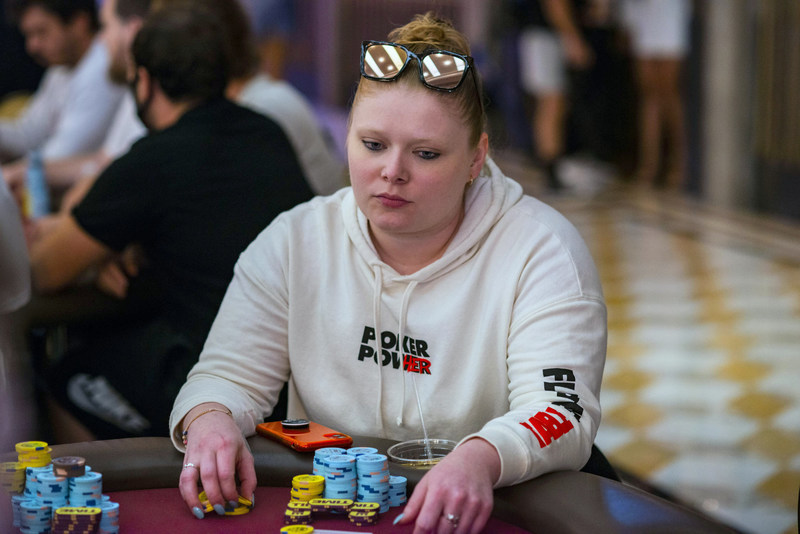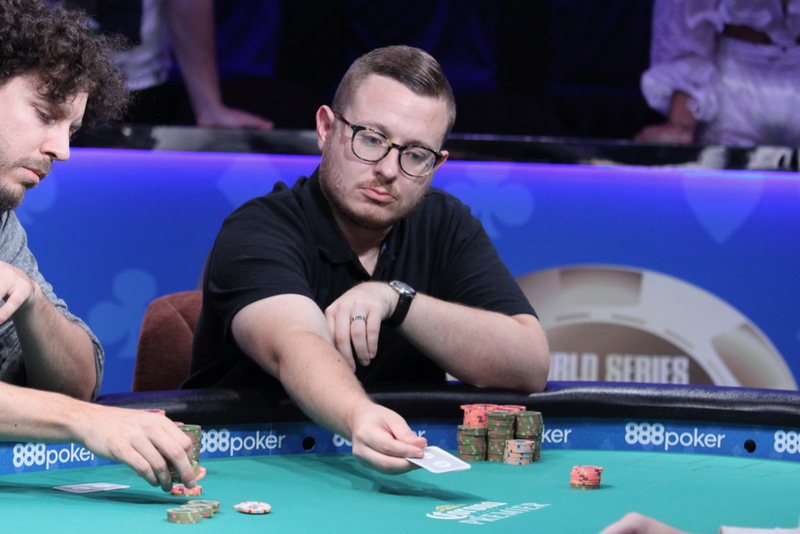






Head Games: Scouting Your Opponents To Exploit Themby Craig Tapscott | Published: Feb 23, 2022 |
|
|

The Pros: Kyna England, Mike Holtz, and Brian Hastings
Craig Tapscott: What kind of information are you looking for when scouting out an unfamiliar opponent or when encountering a past nemesis at a final table?
Kyna England: When I sit down at a table I love to socially interact with people and get them to warm up to me a little bit. I think poker is more fun and productive when we are all having a good time, not just sitting like boring strangers at a table silently. But still, even though I am laughing and talking, I am always watching people play their hands. I am a noticer. I keep track of things people do that I think are interesting or different and I wonder to myself why they would do that.
If I am in a hand, I always watch the players before I look at the board. I like to watch how they study the flop before they act, how they handle their chips, where they look, then process all the play before I look at the community cards and make my decision with all the information available. Bet sizing is probably one of the biggest things I will look for when feeling out a player. How much a player bet in certain spots gives a lot more information than people think.
I also try to follow my own instincts. Sometimes I’ll go to make a bet, but then I look back at a player and the voice in the back of my head goes “don’t.” I try to listen to that voice whenever I can. It has been right quite a bit, and even when it’s not, sometimes you win anyway.
If I have history with a player, I might be more passive than usual or more aggressive, but I will use my own previous experience. I don’t really research players in advance. I like to form my opinion on people in general based on what I witness while encountering them. I remember a lot of hands and a lot of faces, so if we have played together before, chances are I remember.
 Mike Holtz: If available I tend to look at my opponents online and live results. This helps me know what type of experience my opponent has. A player with $7 million in earnings will certainly play different that one who has $31,000. The main difference between a seasoned pro and an amateur is how they approach late game play.
Mike Holtz: If available I tend to look at my opponents online and live results. This helps me know what type of experience my opponent has. A player with $7 million in earnings will certainly play different that one who has $31,000. The main difference between a seasoned pro and an amateur is how they approach late game play.
When I play against unfamiliar opponents, I look to find any pattern I can recognize to exploit, whether that’s bet sizing, timing, or in live settings eye or hand movement. Bet sizing tells can come in many forms. Preflop an opponent may size larger with premium hands and smaller with speculative hands. On the river a player may snap jam all in on a card that should require thought. This tends to be a bluff. Experience is key, over time your subconscious will recognize patterns. I trust my instincts and use this to my advantage.
With elite opponents I’ve played with, I try to identify how they view me and attempt to counter their exploits. I am always trying to see one step ahead of my opponent. It’s important not to have tunnel vision and incorporate as many factors as we can to come to the correct decision on every street.
Use information gathered at the table to your advantage. Often having a friendly conversation with your opponent can give you what I call “friendship equity.” You may be able to get a bluff through because you’re such a nice guy. I mean you did just have a friendly conversation after all, would you really bluff your friend?
Brian Hastings: The one main thing I do when scouting a final table is Googling some unfamiliar opponents to find out some info. Most commonly I just search to find an opponent’s past tournament results. When looking at those results, there are a few things I’m looking for. How much live tournament success has my opponent had? What types of tourneys does he/she typically play? How long has he/she been playing live tournaments for? Has he/she been playing more, less, or about the same amount recently relative to prior years?
I also sometimes expand my search after this. For example, I recently played with an opponent I was unfamiliar with. His [profile page] showed not too many results, but one was a $1,700 WSOP Circuit main event win, and he had a few other cashes in $5,000+ buy-in tournaments recently. I found an article recapping the win and learned some valuable background info from that. The whole point of all this is to gain info and get an idea of what type of player an opponent seems to be. It’s an inexact science, but still helpful compared to just going in with no read.
As far as other preparation, I think studying ICM (Independent Chip Model) spots prior to a final table is valuable, since they will inevitably come into play. I’ll work with programs like Hold’em Resources Calculator and sometimes watch topical training videos to help prepare. Also, getting good sleep and food leading up to the final table is vital to stay mentally sharp throughout.
Craig Tapscott: So now you’re armed with some solid reconnaissance regarding your opponents, what’s the best way to adjust and exploit their weaknesses?
 Kyna England: There are small things I will do to adjust my game based on player intel or what I notice new players doing. Most of those things center around bet sizing and pot control. For example, if I have a tough player in the big blind, I might open a little larger, knowing they will most likely defend pretty wide and maybe not raise as frequently with weaker holdings.
Kyna England: There are small things I will do to adjust my game based on player intel or what I notice new players doing. Most of those things center around bet sizing and pot control. For example, if I have a tough player in the big blind, I might open a little larger, knowing they will most likely defend pretty wide and maybe not raise as frequently with weaker holdings.
I was playing a tournament one time, when I had a very tough table, meaning there were four very good, very aggressive players to my left. It handcuffed the way that I played. But like any other table, it is a puzzle that we must figure out. How do we combat this? In that specific instance I tightened up my opening range and loosened up my calling range. I tried to open bigger with strong hands and only call with good drawing/connected hands in position that play well multi-way. I would do everything I could to just control the pot better and try not to let things get out of line.
I am not sure that I would do that in every situation. It’s important to look at every situation with fresh eyes. Every table, every game, every player is going to provide a diverse and unique experience. Pay attention, test out different things, and find the correct formula to fit the current climate, and most importantly adapt to survive at all costs.
Mike Holtz: The first thing I do is decide based on the experience of my opponents how much I think I should deviate from standard strategy. If someone is less experienced, I would likely open to 2 big blinds instead of opening to 2.2+. I would loosen my opening range if I thought I would be three-bet less often, and conversely if I thought they would three-bet me more often I would open less and four-bet more. My recommendation to most is to be more aggressive, while folding to river aggression against your average opponent.
The second thing you can look into is timing tells. Timing tells present themselves online and on the felt. Try to pay attention to hands you are not involved in. You can get a baseline for how they normally bet, their timing etc. Once you see a showdown or two from them you can start to get a feeling for when they do or don’t have a strong hand.
You can watch an opponent’s hands when they bet. How do they push their chips forward? What do they do with their hands when they aren’t betting? A great way to exploit opponents is to bluff them when you see them do things that you know are not strong. If we see are opponent play two hands when his hands are shaking and he shows down the nuts, then we can bluff the pants off them later when their hands are steady. We have to be careful with how often we “go for it” because opponents will catch on, but in my opinion exploiting weaker opponents is where the majority of a professional’s money will come from in poker.
Another thing. You know that moment you see someone clearly have the nuts? Everyone at the table can tell he has it, the way he bets, the way he’s acting, his breathing etc. What I do is I take what he did and act like that myself or bet like he does but as a bluff. Remember not to use this against the best players in the world, but against amateurs or unknowns giving out false tells can be very helpful in getting a bluff through.
 Brian Hastings: Once I have a best estimate of how I expect an opponent to play, I want to make the proper adjustments relative to how I would play against an opponent playing near-optimally.
Brian Hastings: Once I have a best estimate of how I expect an opponent to play, I want to make the proper adjustments relative to how I would play against an opponent playing near-optimally.
If I final table a $5,000 tourney and I see that an opponent typically plays $300 local tournaments, I would infer that the pay jumps will mean a lot to him/her and apply extra pressure to exploit that. If I Google my opponent and find out that he’s a hedge fund manager for whom the pay jumps should mean very little, I’ll adjust the opposite way and be more selective with pressure, avoiding spots that ICM would justify in theory, but won’t work well in practice against this player type.
Against a player I find to be strong, I won’t adjust at all without more specific reads. Generally, I take a Bayes’ Theorem-based approach to gathering info and making adjustments. This means that I start out with my baseline strategy and adjust some to make exploits when I learn info that justifies doing so, but I’m also careful not to update too much from my priors based on just a few circumstantial pieces of info. The most important insights will typically come once we actually start playing together and I get to form more specific reads. ♠
Kyna England had a breakout year on the tournament circuit in 2021. The Chicago poker pro finished third in the $5,000 DeepStack at Venetian for $448,000 and then added another $186,000 by winning the MSPT Minnesota Winter Poker Classic. She was the highest ranked woman in the Card Player Player of the Year race and won MSPT POY honors. You can find her on Twitter @Kyna_CooL or at pokerpowher.com.
Mike Holtz is one of the top online pros in the United States. The Ocean City, Maryland native earned more than $1 million online in 2021 en route to winning the WSOP.com Player of the Year award. Follow Holtz on Twitter @MikeHoltz47.
Brian Hastings was already one of the top online players in the world before he could even legally play live poker, having won a record $4.18 million in a single session against Viktor ‘Isildur’ Blom. The Hanover Township, Pennsylvania native won his fifth bracelet at the 2021 WSOP, and has more than $4.5 million in live tournament cashes. The Run It Once poker coach can be found @brianchastings.
*Photo credits: PokerNews/Melissa Haereiti & Katerina Lukina, WPT/Joe Giron, Card Player/Erik Fast
Features
Tournaments
Strategy
Commentary & Analysis